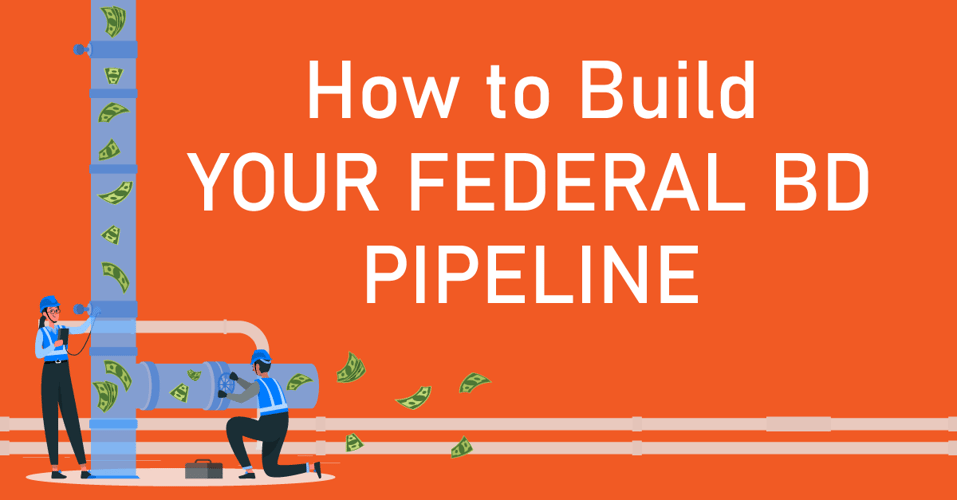
We have all heard about the importance of maintaining a healthy business development pipeline—an organized, visual way of tracking multiple potential buyers (federal agencies) and developing (or stalled) opportunities through different stages in the government contracting procurement process.
But most don’t understand that a pipeline’s importance goes beyond a mere list of potential contacts or contracts. In this article, we'll discuss why a healthy federal contracting opportunity pipeline is important.
1. It indicates how likely you will be in achieving your target/goal
Ideally, your opportunity pipeline is integrated with your Customer Relationship Management (CRM) tool enabling you to accurately assess how close [or far] you are away from the source [the potential buyer].
Many tools out there are happy to provide you with the basic information for a price, but never underestimate the power of the human element. An online platform is not going to tell you if you are in good standing with the buying agency, have excellent references, or have good past performance.
We all want to shoot for the moon, but some federal contract opportunities are simply wishful thinking. In this competitive environment, you can’t get your foot in the door without doing a little relationship management first.
2. It runs a forecast that will highlight opportunities that you expect to close and when you will close them
In the commercial sector, the purchasing timeline is normally 30/60/90 days, whereas in the federal government sector it ends up being more like six months, nine months, [extension], nine months, protest, two years, protest.
I exaggerate [not really] – but an up-to-date opportunity tracker will at least remind you what you need to follow up on.
3. It assists you in allocating resources.
There’s nothing like not tracking an opportunity, and then when it drops looking around frantically for proposal development assistance or a free hand.
4. Provides you with the ability to identify trends.
Your business development team will benefit from the consistent gathering of data on a buying agency, a particular buyer, or an opportunity.
By creating historical snapshots of contacts or contracts, you are given the unique 10,000-foot view regarding projections and will suddenly start noticing connections and trends. We know building a pipeline is imperative to meeting your upcoming business goals for each fiscal year, but where do you start?
The first step in developing a helpful pipeline is creating a targeted marketing campaign.
A targeted marketing campaign is essential as it correctly defines and identifies whom or what would benefit from your offering and value proposition. Anyone or anything that buys what you are selling. Examples are:
- Government agencies, departments, or offices
- Commercial partners
- Federal, state, and local procurement opportunities
- Federal, state, and local Prime contractor
Think of it as the bottom of a pyramid, more is more here because you will refine your list as you move through the process. Once you have identified your potential buyers, you then have to answer the following questions:
- Who does the buying?
- Whom specifically do you need to contact?
- Why do you want to talk to them?
- What is your objective?
Regardless of where you are in this process, you will always have to do your homework to answer some of these questions. Accurate research is critical to understanding your buyer’s budget, mission, goals, and problems.
Furthermore, the answers to these questions also depend on what time in the fiscal year it is. Understanding outside factors will make all the difference in staying ahead of the competition. Research tools and resources include:
- FBO.gov
- FPDS.gov
- USASPENDING.gov
- Congressional budget justifications, appropriations, and reports
- Free industry and OSDBU small business days
- Agency forecasts and budget requests
- GovCon Databases (GovWin, GovBrew, FedMine, etc.)
Conducting accurate research also will help you understand how you can help that federal agency buyer meet its goals, objectives or solve a pain point. This could be:
- Meeting socio-economic goals
- Quickly turn around a need (simplified acquisitions)
- Fill a Prime’s gap or specialized niche requirement
- Assist with consolidation efforts or challenges
When you are ready to grade your homework, you should be able to answer these questions [and document!] about each potential buyer:
- Do they have the approval to use a purchase card?
- When was the last time they bought what you are selling?
- Is this a cold call or can you get an introduction?
- Are they familiar with your offering or brand?
- Who is currently walking the halls?
- How do they buy?
NEXT STEPS:
Now that you have done your federal agency research, documented the data, and analyzed the information – you are now ready to execute your targeted marketing campaign. Armed with tailored marketing materials, you and your team are ready to make those cold calls, send those emails, and walk those halls while using your research as your guide.
Once you see success, it will be easy to convince yourself why it is important to keep your federal opportunity pipeline accurate and current throughout the fiscal year making it a staple of your business development team.








